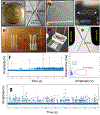Label-free counting of affinity-enriched circulating tumor cells (CTCs) using a thermoplastic micro-Coulter counter (μCC)
- PMID: 31867587
- PMCID: PMC7350181
- DOI: 10.1039/c9an01802f
Label-free counting of affinity-enriched circulating tumor cells (CTCs) using a thermoplastic micro-Coulter counter (μCC)
Abstract
Coulter counters are used for counting particles and biological cells. Most Coulter counters are designed to analyze a sample without the ability to pre-process the sample prior to counting. For the analysis of rare cells, such as circulating tumor cells (CTCs), it is not uncommon to require enrichment before counting due to the modest throughput of μCCs and the high abundance of interfering cells, such as blood cells. We report a microfluidic-based Coulter Counter (μCC) fabricated using simple, low-cost techniques for counting rare cells that can be interfaced to sample pre- and/or post-processing units. In the current work, a microfluidic device for the affinity-based enrichment of CTCs from whole blood into a relatively small volume of ∼10 μL was interfaced to the μCC to allow for exhaustive counting of single CTCs following release of the CTCs from the enrichment chip. When integrated to the CTC affinity enrichment chip, the μCC could count the CTCs without loss and the cells could be collected for downstream molecular profiling or culturing if required. The μCC sensor counting efficiency was >93% and inter-chip variability was ∼1%.
Figures





References
-
- A. Pierzchalski, M. Hebeisen, A. Mittag, M. Berardino and A. Tarnok, 2010.
-
- Dharmasiri U, Witek MA, Adams AA and Soper SA, Annual review of analytical chemistry, 2010, 3, 409–431. - PubMed
-
- Demori M, Ferrari V, Farisè S, Poesio P, Pedrazzani R, Steimberg N, Boniotti J. and Mazzoleni G, Procedia Engineering, 2012, 47, 1247–1250.
MeSH terms
Grants and funding
LinkOut - more resources
Full Text Sources
Medical

